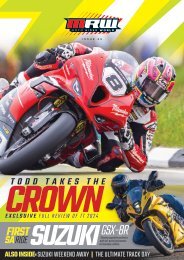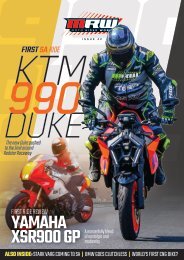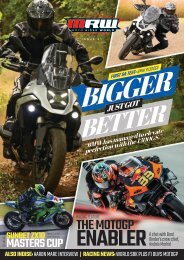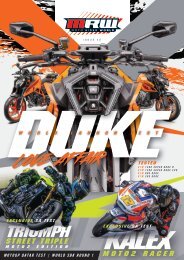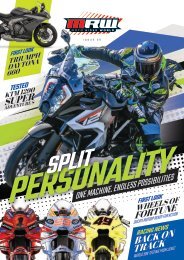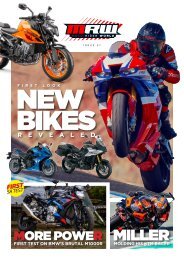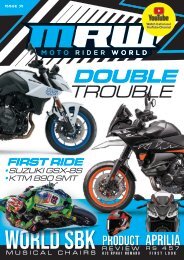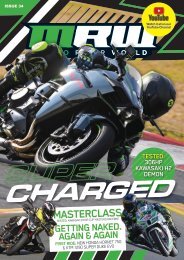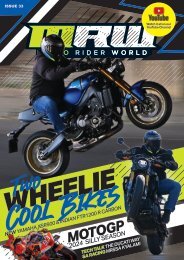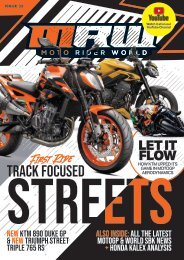MRW Issue 27
You also want an ePaper? Increase the reach of your titles
YUMPU automatically turns print PDFs into web optimized ePapers that Google loves.
NEWS DESK<br />
Honda debuts new in-line<br />
twin CB750 Hornet<br />
Ten years after the mid-sized naked<br />
sportbike CB600F Hornet went out of<br />
production, Honda is plotting its return with<br />
claims of a class-leading power-to-weight<br />
ratio from its brand new 755-cc inline twin.<br />
The motor will also power the upcoming<br />
revival of the Transalp.<br />
Honda hit the jackpot in 1997 when it<br />
detuned a CBR600 supersport four-cylinder<br />
engine, and built around it a naked sporty<br />
roadster with quality parts and more than 90<br />
hp at the crank. The CB600F Hornet became<br />
an overnight success in Europe, remaining<br />
in production through a series of updates<br />
and facelifts until 2013. At that point, Honda<br />
substituted it with the tamer CB650F which<br />
over time evolved to the CB650R.<br />
In order to power the 2023 CB750 Hornet,<br />
Honda couldn’t rely on its existing NC750<br />
motor as it lacks the necessary punch and<br />
sporty disposition. Evolved from half a<br />
Honda Jazz (aka Honda Fit) car engine,<br />
the NC750 is an undersquare, low-revving<br />
twin designed for relaxed commuting and<br />
astounding fuel savings.<br />
The new engine is an inline twin with<br />
Unicam cylinder heads which use a single<br />
camshaft to control four valves – a setup of<br />
CRF450R and Africa Twin fame. Measuring<br />
755 cc in capacity, it produces 90.5 hp at<br />
9,500 rpm and 7.7 kgm at 7,250 rpm at<br />
the <strong>27</strong>0-degree crankshaft, via a six-speed<br />
gearbox and a slipper clutch.<br />
Honda suggests that at 2.81 kg/kW, the 2023<br />
CB750 Hornet tops its class, also thanks to its<br />
relatively low weight. With the 15.2-l fuel tank<br />
full, the bike tips the scales at just 190 kg.<br />
It is equipped with a series of adjustable<br />
electronic support systems that include<br />
traction control, wheelie control, engine<br />
braking and engine power modes. The<br />
rider can harness the Hornet’s power via<br />
four selectable riding modes, consisting<br />
of three presets – sport, standard, and<br />
rain – and a user-programmable mode,<br />
as each dials in different values for the<br />
aforementioned systems.<br />
This engine sits in a new steel diamond-type<br />
frame that weighs 16.6 kg (36.6 lb) – two<br />
less than that of the outgoing CB650R –<br />
suspended on a Showa kit that features<br />
41-mm SFF-BPTM inverted forks and a<br />
Pro-Link monoshock, offering only spring<br />
preload at the rear in terms of adjustability.<br />
Braking is handled by Nissin, with two 296-<br />
mm (11.6-in) disks and four-piston radially<br />
mounted calipers at the front, as well as<br />
a rear single 240-mm (9.5-in) disc with<br />
a single-piston unit. The whole system is<br />
supported by a traditional two-channel<br />
ABS system, without cornering abilities that<br />
would require a more elaborate and costly<br />
inertial engine control unit.





